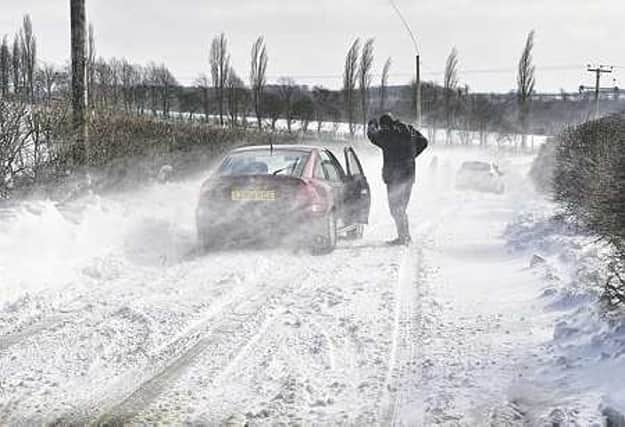Driving in wet wintry weather


As a motoring writer with an MSA race licence, motorcycle licence and advanced driving licence from the Institute of Advanced Motorists (IAM) I am all too aware of the hazards these conditions can create - no matter how confident a driver you are.
My own vivid memories of winter driving include the hair-raising extraction of my brother, sister-in-law and grandmother from a farmer's field on Christmas Day after black ice sent me (driving my mother's car) slithering off an icy country lane.
Advertisement
Hide AdAdvertisement
Hide AdMore recently, I've tip-toed the length of the borough in a Porsche 911 in foot-deep snow to meet an official from Porsche UK.
The combination of 300bhp and summer tyres on a £70,000 sports car in those conditions? Cautious is not the word...
When the conditions get icy we have to be on our guard, no matter what we are driving. Here we have an array of winter driving tips to help you survive winter on the roads without a situation which leaves an 80-year-old stranded in a soggy cow field.
Common sense winter driving tips:
Visibility is everything. Don't drive off without cleaning your windows or side mirrors.
Advertisement
Hide AdAdvertisement
Hide AdEnsure you use a good quality scraper and newly bought de-icer and switch on your internal heater settings to clear away mist and condensation.
Always switch on the car's air conditioning and set up the heater to re-circulate the air around the car rather than pulling cold air in from outside. This will help the car warm-up more quickly and the windscreen to clear more quickly.
Whatever you do, do not pour hot water on to your windscreen as this is likely to freeze up straight away or cause the glass to crack.
Tyres are key in winter. Most UK drivers travel on summer rubber all-year-round but winter tyres and all-weather tyres - the default in many countries in mainland Europe - are a far better option in conditions below 4 deg C.
Advertisement
Hide AdAdvertisement
Hide AdMany tyre dealers and car manufacturers, including Jaguar and BMW, now offer a service which will see them store your summer rubber during the winter months so that the car can ride on winter tyres when needed.
The added control winter tyres offer in snowy or icy conditions has to be experienced to be believed.
For owners of rear-wheel-drive cars, which suffer from loss of traction in ice and snow, winter or all-weather rubber could be the difference between getting to their destination or abandoning their vehicle.
Top winter tyre brands: Continental ContiWinterContact, Pirelli Sottozero, Dunlop SP Winter Sport.
Advertisement
Hide AdAdvertisement
Hide AdTread carefully. Even with your tyres sorted, it is essential that you drive to the conditions.
Always exercise caution if the temperature drops below 4 deg C.
On snow, setting off in second gear will help to keep your revs low and result in greater traction when setting off from a standstill.
Once up and running, drive carefully to avoid the need to brake abruptly - it's likely that you won't stop quickly anyway. Slow down early for junctions and keep moving whenever possible to avoid getting stuck on inclines.
Advertisement
Hide AdAdvertisement
Hide AdIn icy conditions remain alert and be aware of areas where ice may have developed, in particular exposed locations and areas prone to standing water.
Also, make sure you increase the distance between your car and the vehicle in front. Stopping distance on ice increase by up to ten times.
It may sound like overkill to many, but in the worst weather conditions it is worth carrying a winter survival kit that extends beyond de-icer and an ice scraper.
The IAM's chief examiner, Peter Roger, said that a shovel, torch, blanket, jump-leads and tow rope should all find a home in your car at winter.
Advertisement
Hide AdAdvertisement
Hide AdEnsuring that your mobile phone is fully charged and that some warm weather clothing is kept in the car, might also be a wise precaution.
Peter Rodger said: "Many of the problems associated with travel during snow could be avoided if people planned in advance.
"People routinely travel with only the minimum of safety equipment, without realising their journey could be a lot longer than expected."
UNDER ROAD HEATING COULD BEAT THE FREEZE
IT sounds like an out-of-season April fool’s joke but Britain could soon lead the way in the provision of heated road surfaces.
Advertisement
Hide AdAdvertisement
Hide AdAmbitious renewable energy experts ICAX have already seen its plan to keep the roads clear of ice and snow come to fruition with the trial of its solar-powered road heating system.
The London-based firm saw a trial of the system, which harvests energy when the sun shines using solar energy, implemented on a road near to the M1 motorway, at Toddington, in 2005.
At the time Mark Hewitt, director of ICAX Ltd, said: "The UK is currently in a position to become a global leader in the development and exploitation of solar road energy."
Despite a successful trial at Toddington, ICAX's inventive solar road system has yet to be rolled out to its planned application on motorways and runways across the UK.